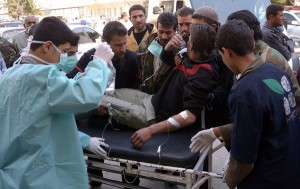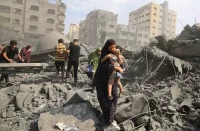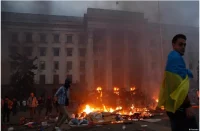While the US President Barack Obama was visiting Middle East, the Syrian opposition tried to accuse Damascus of applying chemical weapons in order to provoke United States to intervene militarily in the Syrian conflict. The opposition knows well that the United States considers the use of chemical weapons a red line and that crossing it could evoke a harsh reaction from Washington, including the imposition of a no-fly zone and the dispatch of a military force. The opposition is also suggesting to Paris and London that they utilize the incident as an argument for circumventing the EU embargo and supplying the Syrian militants with heavy weapons.
The makeshift manufacture of the munition and the selection of primarily civilian targets in the village of Khan al-Asal, which has been alternately under the control of both the regime and the rebels, indicate that the “chemical” attack is either a provocation or a terrorist attack by the insurgents. It is the opposition that controls the area of the Syrian-Turkish border adjacent to Aleppo where the “chemical” attack originated. A chemical plant that uses chlorine in its production cycle is also located there, and Turkish missiles have recently been deployed to the area.
 The symptoms of those injured in the explosion (the number of casualties was small; effects were relatively minor; the chemical picture was slow to develop; and the agent was highly stable) indicate that chlorine or non-military compounds of chlorine were used as the toxic substance. US intelligence also agrees with those conclusions. Based on the symptoms displayed by the Syrians, we can also conclude that the toxic substance may have included phosphorus, chlorine and, probably, “Agent 15” (the Turkish Armed Forces have a similar agent in their inventory).
The symptoms of those injured in the explosion (the number of casualties was small; effects were relatively minor; the chemical picture was slow to develop; and the agent was highly stable) indicate that chlorine or non-military compounds of chlorine were used as the toxic substance. US intelligence also agrees with those conclusions. Based on the symptoms displayed by the Syrians, we can also conclude that the toxic substance may have included phosphorus, chlorine and, probably, “Agent 15” (the Turkish Armed Forces have a similar agent in their inventory).
If a nerve gas (mustard or sarin) in the Syrian Army’s inventory had been used, it would have produced lethal symptoms with many more casualties. Although the toxic substance used did not include a standard military component found in the inventory of the Syrian armed forces or any other country, professional knowledge and specialized equipment would have been required to make it despite its improvised nature, meaning foreign experts were involved.
This detonation of a munition containing a toxic substance in the Middle East is viewed as a clear provocation intended to further destabilize the situation in Syria, which already has a contrived exacerbated nature.
The news is currently paying dividends in the propaganda battle against Damascus. Under the circumstances, we can expect that the West will attempt to initiate a discussion about the current government’s inability to control hazardous production facilities and will push for a more rigorous and meaningful response by the international community.
Given recent statements by Turkey, which has given the rebels unknown types of rockets, it appears that the mechanism for a speedy resolution to the Assad problem is already in motion. The recent chain of events may serve to confirm that. They include the chemical attack in Aleppo, statements by NATO’s Supreme Allied Commander Europe James Stavridis about the possibility of using Patriot systems in Turkey to establish a no-fly zone over Syria and the willingness of the bloc to execute a “Libyan scenario” in the Republic, the “election” of a prime minister by the “opposition coalition,” discussions in the EU about the need to supply arms to the Syrian rebels, the concentration of Israeli forces on the Syrian border, and the kidnapping of Syrian soldiers by neighboring countries’ intelligence services, among others.
Irate over the Syrian army’s military successes, the Western Friends of Syria Group was actively involved in creating a pretext like the Gleiwitz incident to justify intervening in Syria’s internal conflict. The West does not even need a pretext; all it needs is the right political issue. It could be a demand that inspectors be allowed to visit chemical weapon production and storage facilities after another chemical weapon is used in the “right location.” The predictable refusal by Syrian authorities would be used to argue for a military operation to take control of those facilities. Then the elite Syrian forces guarding those facilities would unavoidably be destroyed, air defense systems suppressed, and elements of a no-fly zone imposed. Various options are possible.
The ever deepening crisis in Europe is pushing European leaders towards war, one that would be small and victorious, especially for Paris and London, as the only means of solving their domestic economic problems.
Then, a Libyan-style scenario would follow…
Source: New Eastern Outlook














Comments